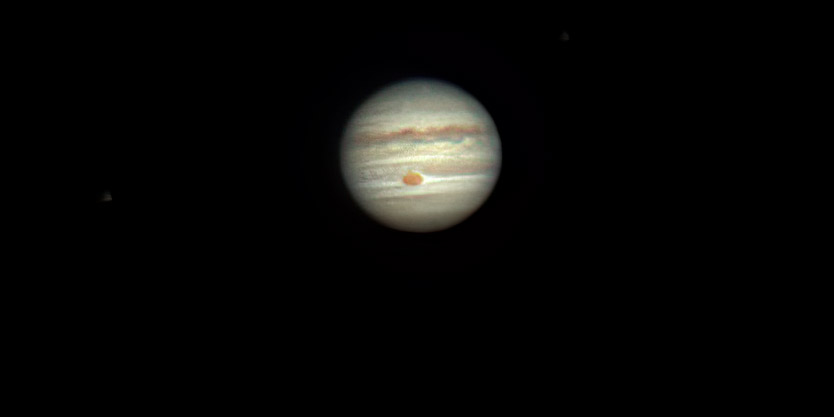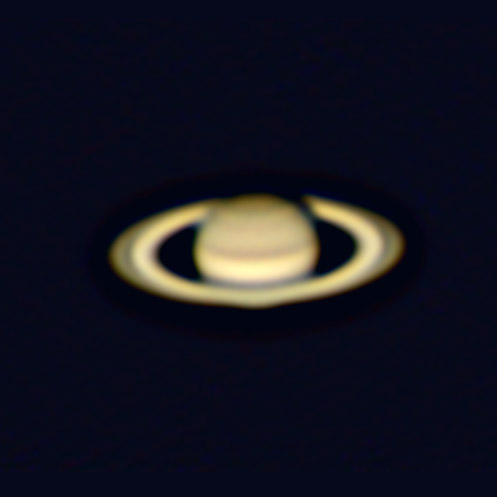
A Brief Observer’s Guide to Jupiter and Saturn
September 2020 :
It is unlikely the local observatories will re-open for in-person observing any time soon due to the surging coronavirus pandemic. (See Frosty Drew Observatory exception below.) Regardless, the heavens above continue to provide a wide assortment of beautiful sky objects to explore if you have the equipment to do so. So, if you have a small telescope in the attic, closet, or garage or shed, now is a great time to resurrect it and put it to good use. Telescopes should be collecting starlight, not dust. And from now until the end of the year, you should focus your attention on the two largest planets in our solar system—Jupiter and Saturn.
On September 1, Jupiter and Saturn will be approximately 414,600,000 and 860,000,000 miles from the Earth respectively. But don’t let that distance deter you from exploring these beautiful worlds. They will exhibit much detail, especially when you know what to expect. This brief guide will highlight some of the key features and events that can be readily observed with a telescope you may already own. Let’s get started on our journey of exploration.
Within one-half hour after sunset (7:18 p.m.) on September 1, look towards the south-southeast sky about 21 degrees above the horizon. The first planet to emerge from the bright evening twilight will be brilliant Jupiter. Soon thereafter a dimmer Saturn will become visible about eight degrees to the left (east) of Jupiter. You may begin observing immediately, though waiting for the sky to darken will certainly provide a better view. During this viewing season these planets are located in the constellation of Sagittarius.
Jupiter
What will you notice first? My guess is Jupiter’s four Galilean moons, named for Galileo Galilei who first observed them in 1610. On this night, Ganymede will be very close to Jupiter’s limb (edge) on one side of his disk, while on the opposite side will be Io, Europa and Callisto in that order outward from the planet. Watch carefully as Ganymede moves away from the disk. This moon will begin to slide into Jupiter’s shadow and will be eclipsed by around 8:37 p.m.
After watching this special event, turn your attention to Jupiter’s banded atmosphere. You will be observing Jupiter’s cloud tops, comprising dark bands and light zones. Since Jupiter rotates in ten hours, you can easily watch features in the cloud structure move over time. The Great Red Spot (GRS) may or may not be visible, depending on when you look. It has been shrinking in size, and is also now more round than oval-shaped. However, its color has reddened over the last couple of years which should help you find it if it providing the GRS is facing the Earth. The GRS resides in the southern part of the dark South Equatorial Belt and extends into the light south tropical zone. Good seeing conditions will help you to detect it.
While the Galilean moons parade around Jupiter, other events besides eclipses can be viewed. When a moon passes in front of Jupiter and casts a shadow onto the Jovian cloud tops, it is called a shadow transit. Besides seeing the satellite’s shadow, you may also see the bright disk of the satellite traversing Jupiter’s clouds at the same time, though this event is more difficult to observe. A moon may also pass behind the planet, which is called an occultation. There are websites which provide predictions for such events, but it can be just as fun to be surprised when you just happen to “catch” one during the time you are observing. Every night you observe Jupiter and his moon’s you will have a unique experience.
Saturn
Could there possibly be a more beautiful planet than Saturn in the universe? Most likely, considering the billions of worlds out there in the cosmos. However, we are only able to observe Saturn and its magnificent system of rings that orbit the planet. And that is where Saturn’s beauty lies. Without rings Saturn would be fairly boring.
 Currently the rings are tilted about 21 degrees towards the Earth providing us a view of the north face of the ring plane. It is really amazing that Saturn’s rings are visible at all, considering the planet’s great distance from the Earth and the fact that the main A, B and C rings are only about 32 feet thick. The rings are composed of irregularly shaped dirty snowballs (99 percent water ice with some rocky material), ranging in size from grains of dust to pebbles. There are also some “boulders” as large as 30 feet across. Look for gaps within the ring system.
Currently the rings are tilted about 21 degrees towards the Earth providing us a view of the north face of the ring plane. It is really amazing that Saturn’s rings are visible at all, considering the planet’s great distance from the Earth and the fact that the main A, B and C rings are only about 32 feet thick. The rings are composed of irregularly shaped dirty snowballs (99 percent water ice with some rocky material), ranging in size from grains of dust to pebbles. There are also some “boulders” as large as 30 feet across. Look for gaps within the ring system.
Titan, Saturn’s largest moon, is larger than the planet Mercury and will be readily apparent. Depending upon the size of your telescope you may also spot Rhea, Iapetus, Dione and Tethys. These last four moons are nowhere near as bright as Jupiter’s Galilean satellites, so you’ll need a dark sky to glimpse them.
Frosty Drew Observatory (http://www.frostydrew.org/) in Charlestown has reopened for Friday night public viewing under strict COVID-19 mitigation protocols. Access this link for the latest information, https://frostydrew.org/2020-contagion.php, as the pandemic is surging nationwide as I write this column in mid-July.
As the year progresses, Jupiter and Saturn will be moving closer to one another in the sky from our vantage point here on the Earth. On December 21 they will be so close that they will appear as one object to the naked-eye just after sunset 15 degrees above the western horizon. This “Great Conjunction” will be the closest these two worlds have been since 1623, and will be a spectacular event to behold.
Keep your eyes to the skies.



